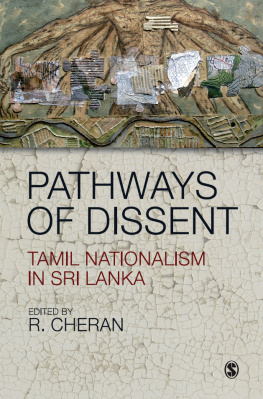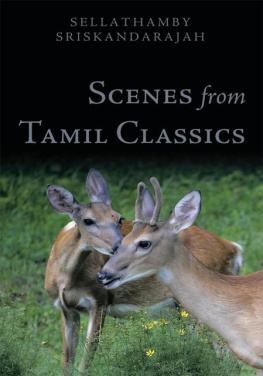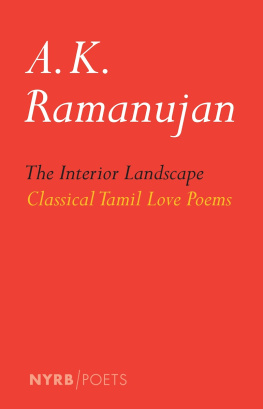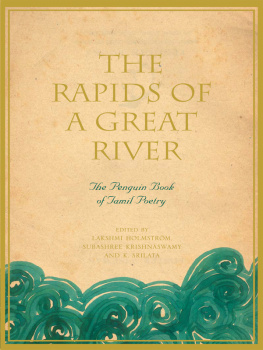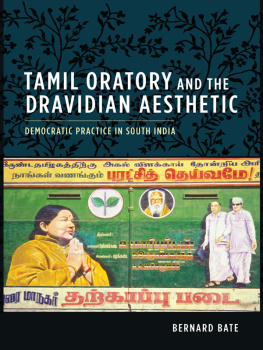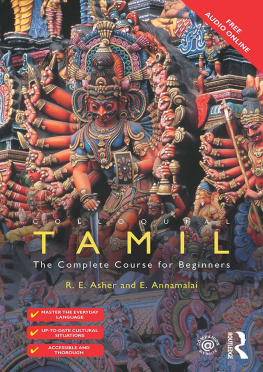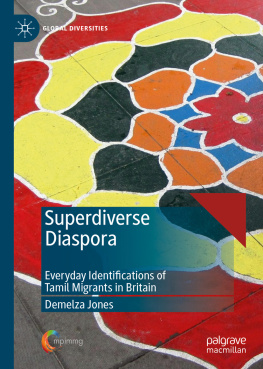Tamil
A BIOGRAPHY

DAVID SHULMAN
The Belknap Press of Harvard University Press
CAMBRIDGE, MASSACHUSETTS
LONDON, ENGLAND
2016
Copyright 2016 by the President and Fellows of Harvard College
All rights reserved
Jacket design: Rathna Ramanathan and Tim Jones
Jacket image: Based on a frontispiece from Centamil Celvam (1911), redrawn by Guglielmo Rossi
978-0-674-05992-4 (alk. paper)
978-0-674-97465-4 (EPUB)
978-0-674-97466-1 (MOBI)
The Library of Congress has cataloged the printed edition as follows:
Names: Shulman, David Dean, 1949 author.
Title: Tamil : a biography / David Shulman.
Description: Cambridge, Massachusetts : The Belknap Press of Harvard University Press, 2016. | Includes bibliographical references and index.
Identifiers: LCCN 2016008042
Subjects: LCSH: Tamil (Indic people)Intellectual life. | Tamil (Indic people)History. | Tamil languageHistory. | Tamil literatureHistory and criticism. | Tamil poetryHistory and criticism. | IndiaCivilization.
Classification: LCC DS432.T3 S46 2016 | DDC 305.894/811dc23
LC record available at http://lccn.loc.gov/2016008042
Book design by Dean Bornstein
For Yigal, Sashi, and Ramacandra Reddy
sasneham
Contents
- lpana
- Pallavi
- Anupallavi
- Caraam
- Caraam
- Caraam
- Rgamlik
A language is never a thing, even if its speakers sometimes do whatever they can to turn it into oneto make it an it. The ideas people have about their language may be things, and as such may have a history; even so, the language will always exceed those ideas and, given certain basic conditions, will continue to grow and thus to fulfill the organic, uncertain, and lively destiny encoded in its grammar. Old languages like Tamil, given to intense reflection over many centuries, write their own autobiographies, in many media, though we may not know how to read them. Sometimes they ask the assistance of a ghostwriter, a biographer, like me.
Everywhere one looks at language, at every point that we touch it, we see movement, aliveness, and singular forms of self-expressionusually not amenable to translation. In the Jerusalem school of linguistics we were taught that there is nothing trivial in language, nothing too minute to be studied and explored. There is, implicit in each point and part, the logic of a system held together from inside and of the world that lives inside that world. I doubt that these worlds are representational in any meaningful sense, but I think they do speak to us. You dont need to know Tamil to hear them.
This is not the book a historical linguist would have written. It is more of a cultural history of Tamil, with particular focus on the understandings and perceptions about the language that came to the surface over the two thousand years of its documented existence. There are thus two stories running concurrently: one about the ways Tamil evolved in itself, generating grammars of speaking and singing and thinking, and one about major expressiveespecially poetic and literarydrives and themes, seen in a broad historical perspective that makes space for continuities. I thought it would be a very short book, essayistic and nonlinear, but Tamil thought otherwise.
The best part of writing it was discovering texts I had never read, or had read long ago and mostly forgotten, or to which I had paid too little attention (in other words, most Tamil texts). I was regularly astonished. Most of these works, many of them masterpieces of human civilization by any standard, belong to the past thousand years or so of Tamil. This means that a certain dissonance has probably found its way into the heart of the book. It is one thing to look at Tamil from the vantage point of the year 1000, or the year 1500; another thing to look backward from 2016 toward both the distant and the recent past. These rival perspectives, largely incompatible, are, in a sense, what this book is about. They are its pruthe hidden stuff of meaning, not always spelled out explicitly.
I hesitated before agreeing to write. Almost everything about Tamil is contentious. Some of the most important questions cannot be answered. We have rather tentative notions about chronology and, in this generation, fierce disputes about identity (not my favorite word). I have had to leave vast swaths of Tamil out of these pages for want of knowledge and want of space. Almost every Tamil reader will see, perhaps before all else, what is missing.
The book is built like a concert, or a composition, kriti, in the Carnatic style. It has an opening lpana, largely focused on grammar; a pallava refrain that speaks of in-ness; an anupallavi secondary refrain about uyir, the core of the Tamil person; and several caraam verses, each with its own primary subject and time period, eventually culminating in a modern rga-mlik rapidly running through diverse rga-scales with a meditative till at the end. The refrain, also the anupallavi, naturally recurs frequently throughout the composition with its caraam variations, as in the performance of any kriti. Any reader who manages to read the whole book, if such a person miraculously appears, will notice a certain set of patterns and melodies. Sadly, unlike the compositions of Muttusvwamy Dikshitar and others, this kriti is unlikely to be conducive to the manifestation of any god or goddess.
Now there are those to be thanked, too many to be mentioned. Still: First among them is my first Tamil teacher and guru, John Ralston Marr, whose love for all things Tamil infused every line of poetry we read. A. Kandiah also taught me, gently and firmly, in those early years. I was fortunate to read many challenging texts with V. S. Rajam in the course of a sabbatical year in Baltimore and Philadelphia. Many good friends on several continents, including two new generations of brilliant scholars of Tamil, sent me their essays and books, read and commented on chapters as they took shape, corrected my errors, and kept up my spirits when the task seemed impossible: Jean-Luc Chevillard, Archana Venkatesan, Vasudha Narayanan, Blake Wentworth, S. Ramakrishnan, Emmanuel Francis, Talavajjhala Sashi Shekhar, Yigal Bronner, Jennifer Clare, Sascha Ebeling, and the ever-generous and insightful Whitney Cox. Franois Gros very helpfully discussed issues of dating. George Hart sent me his wonderful new translation of Akanu. I thank Sivan Goren for our sessions reading Ll-tilakam and Venugopala Panicker for sharing his tremendous knowledge of south Indian linguistics. Ilanit Loewy Shacham plied me with scans of rare Tamil books from the infinitely capacious Regenstein Librarywhen she had far better things to do with her time. Charles Hallisey, who has taught so many of us how to read, read this book in draft and gave me faith that it has some value.
This book, like several of its predecessors, was finished in the utopian space of the Israel Institute for Advanced Studies. I want to thank the devoted staff of the institute and its director, Professor Michal Linial, for nurturing that space. I wish to thank the Israel Science Foundation and the University Grant Commission in India for a joint grant that contributed to the writing of this book. I thank Brian Ostrander of Westchester Publishing Services, and Heather Hughes, Louise Robbins, and Stephanie Vyce at Harvard University Press for help and encouragement at every stage. My editor, Sharmila Sen, gently and firmly nudged me into writing this book, and now that its written, Im more than grateful to her. As always, my wife, Eileen, who has shared the Tamil adventure from the start and who knows how to sing the


